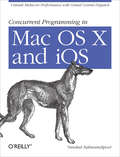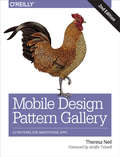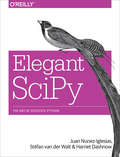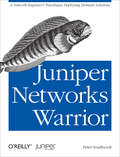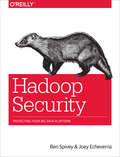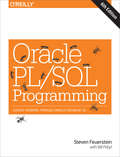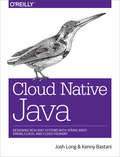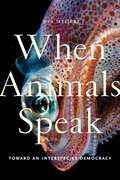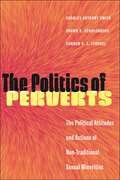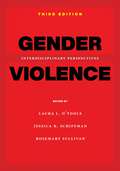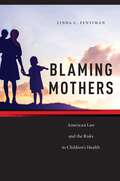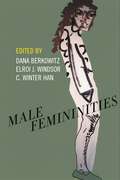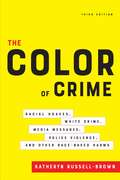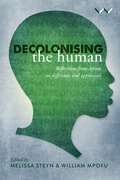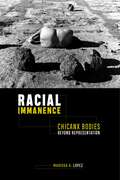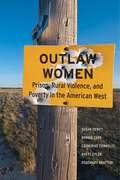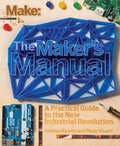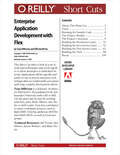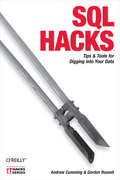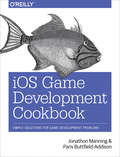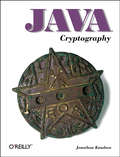- Table View
- List View
Concurrent Programming in Mac OS X and iOS: Unleash Multicore Performance with Grand Central Dispatch (Oreilly And Associate Ser.)
by Vandad NahavandipoorNow that multicore processors are coming to mobile devices, wouldn't it be great to take advantage of all those cores without having to manage threads? This concise book shows you how to use Apple's Grand Central Dispatch (GCD) to simplify programming on multicore iOS devices and Mac OS X.Managing your application’s resources on more than one core isn't easy, but it's vital. Apps that use only one core in a multicore environment will slow to a crawl. If you know how to program with Cocoa or Cocoa Touch, this guide will get you started with GCD right away, with many examples to help you write high-performing multithreaded apps.Package your code as block objects and invoke them with GCDUnderstand dispatch queues—the pools of threads managed by GCDUse different methods for executing UI and non-UI tasksCreate a group of tasks that GCD can run all at onceInstruct GCD to execute tasks only once or after a delayDiscover how to construct your own dispatch queues
Mobile Design Pattern Gallery: UI Patterns for Smartphone Apps
by Theresa NeilWhen you’re under pressure to produce a well-designed, easy-to-navigate mobile app, there’s no time to reinvent the wheel—and no need to. This handy reference provides more than 90 mobile app design patterns, illustrated by 1,000 screenshots from current Android, iOS, and Windows Phone apps.Much has changed since this book’s first edition. Mobile OSes have become increasingly different, driving their own design conventions and patterns, and many designers have embraced mobile-centric thinking. In this edition, user experience professional Theresa Neil walks product managers, designers, and developers through design patterns in 11 categories:Navigation: get patterns for primary and secondary navigationForms: break industry-wide habits of bad form designTables: display only the most important informationSearch, sort, and filter: make these functions easy to useTools: create the illusion of direct interactionCharts: learn best practices for basic chart designTutorials & Invitations: invite users to get started and discover featuresSocial: help users connect and become part of the groupFeedback & Affordance: provide users with timely feedbackHelp: integrate help pages into a smaller form factorAnti-Patterns: what not to do when designing a mobile app
Elegant SciPy: The Art of Scientific Python
by Harriet Dashnow Juan Nunez-Iglesias Stéfan van der WaltWelcome to Scientific Python and its community. If you’re a scientist who programs with Python, this practical guide not only teaches you the fundamental parts of SciPy and libraries related to it, but also gives you a taste for beautiful, easy-to-read code that you can use in practice. You’ll learn how to write elegant code that’s clear, concise, and efficient at executing the task at hand.Throughout the book, you’ll work with examples from the wider scientific Python ecosystem, using code that illustrates principles outlined in the book. Using actual scientific data, you’ll work on real-world problems with SciPy, NumPy, Pandas, scikit-image, and other Python libraries.Explore the NumPy array, the data structure that underlies numerical scientific computationUse quantile normalization to ensure that measurements fit a specific distributionRepresent separate regions in an image with a Region Adjacency GraphConvert temporal or spatial data into frequency domain data with the Fast Fourier TransformSolve sparse matrix problems, including image segmentations, with SciPy’s sparse modulePerform linear algebra by using SciPy packagesExplore image alignment (registration) with SciPy’s optimize moduleProcess large datasets with Python data streaming primitives and the Toolz library
Juniper Networks Warrior: A Guide to the Rise of Juniper Networks Implementations
by Peter SouthwickIn this practical book, Juniper Networks consulting senior network engineer, Peter Southwick, offers unique first-person field studies on designing, configuring, and troubleshooting new systems that are changing the networking world. Each chapter-long "travelogue" follows a team of Juniper Networks warriors as they solve specific needs with emerging network platform architectures.In these case studies, Southwick and his fellow warriors analyze a client’s particular situation, arrive at an architectural solution, and work through the deployment details. For anyone who operates, installs, designs, or works in IT, this book provides an intimate and entertaining look at what’s changing and why.Among the case studies, you’ll discover how:A service provider protected customers from malicious traffic with Juniper Networks IDP systemsSRX5800s improved connectivity and security in a data centerEthernet WAN technology was chosen as a storage solution, rather than a proprietary design on dark fiberAn enterprise severed communications between different departments to comply with government personal credit card standardsCore network and edge devices helped a power company serve local customers and ISPs in the data services marketA hosting company migrated its core, datacenter, edge, and access domains to a state-of-the-art network"In this uniquely written book, you will get a detailed view of life in the data center, the edge, the core, and the office of the customer’s CIO."Steve Fazio, CEO, TorreyPoint
Hadoop Security: Protecting Your Big Data Platform
by Ben Spivey Joey EcheverriaAs more corporations turn to Hadoop to store and process their most valuable data, the risk of a potential breach of those systems increases exponentially. This practical book not only shows Hadoop administrators and security architects how to protect Hadoop data from unauthorized access, it also shows how to limit the ability of an attacker to corrupt or modify data in the event of a security breach.Authors Ben Spivey and Joey Echeverria provide in-depth information about the security features available in Hadoop, and organize them according to common computer security concepts. You’ll also get real-world examples that demonstrate how you can apply these concepts to your use cases.Understand the challenges of securing distributed systems, particularly HadoopUse best practices for preparing Hadoop cluster hardware as securely as possibleGet an overview of the Kerberos network authentication protocolDelve into authorization and accounting principles as they apply to HadoopLearn how to use mechanisms to protect data in a Hadoop cluster, both in transit and at restIntegrate Hadoop data ingest into enterprise-wide security architectureEnsure that security architecture reaches all the way to end-user access
Oracle PL/SQL Programming: Covers Versions Through Oracle Database 12c
by Steven Feuerstein Bill PribylConsidered the best Oracle PL/SQL programming guide by the Oracle community, this definitive guide is precisely what you need to make the most of Oracle’s powerful procedural language. The sixth edition describes the features and capabilities of PL/SQL up through Oracle Database 12c Release 1.Hundreds of thousands of PL/SQL developers have benefited from this book over the last twenty years; this edition continues that tradition. With extensive code examples and a lively sense of humor, this book explains language fundamentals, explores advanced coding techniques, and offers best practices to help you solve real-world problems.Get PL/SQL programs up and running quickly, with clear instructions for executing, tracing, testing, debugging, and managing codeUnderstand new 12.1 features, including the ACCESSIBLE_BY clause, WITH FUNCTION and UDF pragma, BEQUEATH CURRENT_USER for views, and new conditional compilation directivesTake advantage of extensive code samples, from easy-to-follow examples to reusable packaged utilitiesOptimize PL/SQL performance with features like the function result cache and Oracle utilities such as PL/Scope and the PL/SQL hierarchical profilerBuild modular, easy-to-maintain PL/SQL applications using packages, procedures, functions, and triggers
Cloud Native Java: Designing Resilient Systems with Spring Boot, Spring Cloud, and Cloud Foundry
by Josh Long Kenny BastaniWhat separates the traditional enterprise from the likes of Amazon, Netflix, and Etsy? Those companies have refined the art of cloud native development to maintain their competitive edge and stay well ahead of the competition. This practical guide shows Java/JVM developers how to build better software, faster, using Spring Boot, Spring Cloud, and Cloud Foundry.Many organizations have already waded into cloud computing, test-driven development, microservices, and continuous integration and delivery. Authors Josh Long and Kenny Bastani fully immerse you in the tools and methodologies that will help you transform your legacy application into one that is genuinely cloud native.In four sections, this book takes you through:The Basics: learn the motivations behind cloud native thinking; configure and test a Spring Boot application; and move your legacy application to the cloudWeb Services: build HTTP and RESTful services with Spring; route requests in your distributed system; and build edge services closer to the dataData Integration: manage your data with Spring Data, and integrate distributed services with Spring’s support for event-driven, messaging-centric architecturesProduction: make your system observable; use service brokers to connect stateful services; and understand the big ideas behind continuous delivery
When Animals Speak: Toward an Interspecies Democracy (Animals in Context #1)
by Eva MeijerWinner, 2020 ASCA Book Award, given by the Amsterdam School of Cultural AnalysisA groundbreaking argument for the political rights of animals In When Animals Speak, Eva Meijer develops a new, ground-breaking theory of language and politics, arguing that non-human animals speak—and, most importantly, act—politically. From geese and squid to worms and dogs, she highlights the importance of listening to animal voices, introducing ways to help us bridge the divide between the human and non-human world. Drawing on insights from science, philosophy, and politics, Meijer provides fascinating, real-world examples of animal communities who use their voices to speak, and act, in political ways. When Animals Speak encourages us to rethink our relations with other animals, showing that their voices should be taken into account as the starting point for a new interspecies democracy.
The Politics of Perverts: The Political Attitudes and Actions of Non-Traditional Sexual Minorities (LGBTQ Politics)
by Charles Anthony Smith Shawn R. Schulenberg Connor B. StrobelReveals the underexplored politics and activism of non-traditional sexual minoritiesOver the past four decades, there has been significant research focused on the political and social lives of lesbian, gay, and transgender (LGT) individuals, exploring how these sexual communities interact with politicians and voters who identify as straight. However, due to society’s binary view of sexuality, this research has overlooked non-traditional sexual minorities.To address this omission, The Politics of Perverts delves into the political attitudes and activities of individuals who identify with non-traditional sexual orientations and practices, such as Polyamory, BDSM, the Furry Fandom, Nudism, and the large bisexual population within these communities. These groups face similar discrimination, stigma, and lack of legal protections in various aspects of life.The authors shed light on the political identities, affiliations, and attitudes of these communities in theUnited States, revealing how sexuality and politics are even more deeply intertwined at the margins of society. Despite facing challenges, these communities actively engage in political discussions and activities in hopes of fostering greater inclusivity, better representation, and more informed policies.
Gender Violence, 3rd Edition: Interdisciplinary Perspectives
by Laura L. O’Toole, Jessica R. Schiffman, and Rosemary SullivanAn updated edition of the groundbreaking anthology that explores the proliferation of gendered violenceFrom Harvey Weinstein to Brett Kavanaugh, accusations of gender violence saturate today’s headlines. In this fully revised edition of Gender Violence, Laura L. O’Toole, Jessica R. Schiffman, and Rosemary Sullivan bring together a new, interdisciplinary group of scholars, with up-to-date material on emerging issues like workplace harassment, transgender violence, intersectionality, and the #MeToo movement. Contributors provide a fresh, informed perspective on gender violence, in all of its various forms. With twenty-nine new contributors, and twelve original essays, the third edition now includes emerging contemporary issues such as LGBTQ violence, sex work, and toxic masculinity. A trailblazing text, Gender Violence, Third Edition is an essential read for students, activists, and others.
Blaming Mothers: American Law and the Risks to Children’s Health (Families, Law, and Society #3)
by Linda C. FentimanA gripping explanation of the biases that lead to the blaming of pregnant women and mothers.Are mothers truly a danger to their children’s health? In 2004, a mentally disabled young woman in Utah was charged by prosecutors with murder after she declined to have a Caesarian section and subsequently delivered a stillborn child. In 2010, a pregnant woman who attempted suicide when the baby’s father abandoned her was charged with murder and attempted feticide after the daughter she delivered prematurely died. These are just two of the many cases that portray mothers as the major source of health risk for their children. The American legal system is deeply shaped by unconscious risk perception that distorts core legal principles to punish mothers who “fail to protect” their children. In Blaming Mothers, Professor Fentiman explores how mothers became legal targets. She explains the psychological processes we use to confront tragic events and the unconscious race, class, and gender biases that affect our perceptions and influence the decisions of prosecutors, judges, and jurors. Fentiman examines legal actions taken against pregnant women in the name of “fetal protection” including court ordered C-sections and maintaining brain-dead pregnant women on life support to gestate a fetus, as well as charges brought against mothers who fail to protect their children from an abusive male partner. She considers the claims of physicians and policymakers that refusing to breastfeed is risky to children’s health. And she explores the legal treatment of lead-poisoned children, in which landlords and lead paint manufacturers are not held responsible for exposing children to high levels of lead, while mothers are blamed for their children’s injuries. Blaming Mothers is a powerful call to reexamine who - and what - we consider risky to children’s health. Fentiman offers an important framework for evaluating childhood risk that, rather than scapegoating mothers, provides concrete solutions that promote the health of all of America’s children. Read a piece by Linda Fentiman on shaming and blaming mothers under the law on The Gender Policy Report.
Male Femininities
by C. Winter Han Dana Berkowitz Elroi J. WindsorInnovative essays that explore how men perform femininity and what femininity looks like without womenWhat counts as “male femininity”? Is it simply men behaving in effeminate ways or is it the absence of masculinity? Male Femininities presents a nuanced, critical collection of essays that highlight the extent to which male femininities are neither an imitation of femaleness nor an emptying of masculinity. These innovative essays focus on both gay and straight men, and transmasculine and genderqueer people in their construction and performance of femininity, thereby revealing the possibilities that open up when we critically examine femininity without women. Male Femininities asks, What does femininity look like for men?The contributors—highly regarded scholars and rising stars—cover a range of topics, including drag queens, cosmetic enhancements, trans fertility, and gender-non-conforming childhoods. Male Femininities illuminates what happens when we decouple femininity from female bodies and how even the smallest cracks and fissures in the normative order can disrupt, challenge, and in some cases reaffirm our existing sex-gender regime. This volume pluralizes the concept of male femininities and leads readers through an exploration of how gender, sex, and sexuality are manifested in the United States today.
The Color of Crime, Third Edition: Racial Hoaxes, White Crime, Media Messages, Police Violence, and Other Race-Based Harms
by Katheryn Russell-BrownHow we can understand race, crime, and punishment in the age of Black Lives MatterWhen The Color of Crime was first published in 1998, it was heralded as a path-breaking book on race and crime. Now, in its third edition, Katheryn Russell-Brown’s book is more relevant than ever, as police killings of unarmed Black civilians—such as George Floyd, Breonna Taylor, and Daniel Prude—continue to make headlines around the world. She continues to ask, why do Black and white Americans perceive police actions so differently? Is white fear of Black crime justified?With three new chapters, over forty new racial hoax cases, and other timely updates, this edition offers an even more expansive view of crime and punishment in the twenty-first century. Russell-Brown gives us much-needed insight into some of the most recent racial hoaxes, such as the one perpetrated by Amy Cooper. Should perpetrators of racial hoaxes be charged with a felony? Further, Russell-Brown makes a compelling case for race and crime literacy and the need to address and name White crime. Russell-Brown powerfully concludes the book with a parable that invites readers to imagine what would happen if Blacks decided to abandon the United States. Russell-Brown explores the tacit and subtle ways that crime is systematically linked to people of color. The Color of Crime is a lucid and forceful volume that calls for continued vigilance on the part of scholars, policymakers, journalists, and others in the age of Black Lives Matter.
Decolonising the Human: Reflections from Africa on difference and oppression
by Melissa Steyn, William MpofuDecolonising the Human examines the ongoing project of constituting ‘the human’ in light of the durability of coloniality and the persistence of multiple oppressionsThe ‘human’ emerges as a deeply political category, historically constructed as a scarce existential resource. Once weaponised, it allows for the social, political and economic elevation of those who are centred within its magic circle, and the degradation, marginalisation and immiseration of those excluded as the different and inferior Other, the less than human. Speaking from Africa, a key site where the category of the human has been used throughout European modernity to control, exclude and deny equality of being, the contributors use decoloniality as a potent theoretical and philosophical tool, gesturing towards a liberated, pluriversal world where human difference will be recognised as a gift, not used to police the boundaries of the human. Here is a transdisciplinary critical exploration of a wide range of subjects, including history, politics, philosophy, sociology, anthropology and decolonial studies.
Arabian Satire: Poetry from 18th-Century Najd (Library of Arabic Literature #49)
by Ḥmēdān al-ShwēʿirThis lively volume collects poems by Hmedan al-Shwe'ir, who lived in Najd in the Arabian Peninsula shortly before the hegemony of the Wahhabi movement in the early eighteenth century.A master of satire known for his ribald humor, self-deprecation, and invective verse (hija'), Hmedan was acerbic in his criticisms of society and its morals, voiced in in a poetic idiom that is widely referred to as “Nabati,” here a mix of Najdi vernacular and archaic vocabulary and images dating back to the origins of Arabic poetry. In Arabian Satire, Hmedan is mostly concerned with worldly matters, and addresses these in different guises: as the patriarch at the helm of the family boat and its unruly crew; as a picaresque anti-hero who revels in taking potshots at the established order, its hypocrisy, and its moral failings; as a peasant who labors over his palm trees, often to no avail and with no guarantee of success; and as a poet recording in verse how he thinks things ought to be.The poems in Arabian Satire reveal a plucky, headstrong, yet intensely socially committed figure—representative of the traditional Najdi ethos—who infuses his verse with proverbs, maxims, and words of wisdom expressed plainly and conversationally. Hmedan is accordingly quoted by historians of the Gulf region and in anthologies of popular sayings. This is the first full translation of this remarkable poet. A bilingual Arabic-English edition.
Racial Immanence: Chicanx Bodies beyond Representation
by Marissa K. LópezWinner, 2021 NACCS Book Award, given by the National Association for Chicano and Chicana StudiesExplores the how, why, and what of contemporary Chicanx culture, including punk rock, literary fiction, photography, mass graves, and digital and experimental installation artRacial Immanence attempts to unravel a Gordian knot at the center of the study of race and discourse: it seeks to loosen the constraints that the politics of racial representation put on interpretive methods and on our understanding of race itself. Marissa K. López argues that reading Chicanx literary and cultural texts primarily for the ways they represent Chicanxness only reinscribes the very racial logic that such texts ostensibly set out to undo.Racial Immanence proposes to read differently; instead of focusing on representation, it asks what Chicanx texts do, what they produce in the world, and specifically how they produce access to the ineffable but material experience of race. Intrigued by the attention to disease, disability, abjection, and sense experience that she sees increasing in Chicanx visual, literary, and performing arts in the late-twentieth century, López explores how and why artists use the body in contemporary Chicanx cultural production. Racial Immanence takes up works by writers like Dagoberto Gilb, Cecile Pineda, and Gil Cuadros, the photographers Ken Gonzales Day and Stefan Ruiz, and the band Piñata Protest to argue that the body offers a unique site for pushing back against identity politics. In so doing, the book challenges theoretical conversations around affect and the post-human and asks what it means to truly consider people of color as writersand artists. Moving beyond abjection, López models Chicanx cultural production as a way of fostering networks of connection that deepen our attachments to the material world.
Outlaw Women: Prison, Rural Violence, and Poverty in the New American West
by Susan Dewey Bonnie Zare Catherine Connolly Rhett Epler Rosemary BrattonA journey into the experiences of incarcerated women in rural areas, revealing how location can reinforce gendered violenceIncarceration is all too often depicted as an urban problem, a male problem, a problem that disproportionately affects people of color. This book, however, takes readers to the heart of the struggles of the outlaw women of the rural West, considering how poverty and gendered violence overlap to keep women literally and figuratively imprisoned. Outlaw Women examines the forces that shape women’s experiences of incarceration and release from prison in the remote, predominantly white communities that many Americans still think of as “the Western frontier.” Drawing on dozens of interviews with women in the state of Wyoming who were incarcerated or on parole, the authors provide an in-depth examination of women’s perceptions of their lives before, during, and after imprisonment. Considering cultural mores specific to the rural West, the authors identify the forces that consistently trap women in cycles of crime and violence in these regions: felony-related discrimination, the geographic isolation that traps women in abusive relationships, and cultural stigmas surrounding addiction, poverty, and precarious interpersonal relationships. Following incarceration, women in these areas face additional, region-specific obstacles as they attempt to reintegrate into society, including limited social services, significant gender wage gaps, and even severe weather conditions that restrict travel. The book ultimately concludes with new, evidence-based recommendations for addressing the challenges these women face.
The Maker's Manual: A Practical Guide to the New Industrial Revolution
by Patrick Di Justo Paolo Aliverti Andrea MaiettaThe Maker's Manual is a practical and comprehensive guide to becoming a hero of the new industrial revolution. It features dozens of color images, techniques to transform your ideas into physical projects, and must-have skills like electronics prototyping, 3d printing, and programming. This book's clear, precise explanations will help you unleash your creativity, make successful projects, and work toward a sustainable maker business. Written by the founders of Frankenstein Garage, which has organized courses since 2011 to help makers to realize their creations, The Maker's Manual answers your questions about the Maker Movement that is revolutionizing the way we design and produce things.
Agile Enterprise Application Development with Flex
by The EffectiveUI Team Tony HillersonThis Short Cut takes a look at a set of tools and technologies that work together to allow developers to build Rich Internet Applications (RIAs) quickly and easily on top of proven enterprise technologies that are traditionally associated with long, complex development efforts.
Using SQLite: Small. Fast. Reliable. Choose Any Three. (O'reilly Ser.)
by Jay A. KreibichApplication developers, take note: databases aren't just for the IS group any more. You can build database-backed applications for the desktop, Web, embedded systems, or operating systems without linking to heavy-duty client-server databases such as Oracle and MySQL. This book shows you how to use SQLite, a small and lightweight relational database engine that you can build directly into your application.With SQLite, you'll discover how to develop a database-backed application that remains manageable in size and complexity. This book guides you every step of the way. You'll get a crash course in data modeling, become familiar with SQLite's dialect of the SQL database language, and much more.Learn how to maintain localized storage in a single file that requires no configurationBuild your own SQLite library or use a precompiled distribution in your applicationGet a primer on SQL, and learn how to use several language functions and extensionsWork with SQLite using a scripting language or a C-based language such as C# or Objective-CUnderstand the basics of database design, and learn how to transfer what you already know to SQLiteTake advantage of virtual tables and modules"Complex SQL concepts explained clearly."--D. Richard Hipp, creator of SQLite
SQL Hacks: Tips & Tools for Digging Into Your Data
by Andrew Cumming Gordon RussellWhether you're running Access, MySQL, SQL Server, Oracle, or PostgreSQL, this book will help you push the limits of traditional SQL to squeeze data effectively from your database. The book offers 100 hacks -- unique tips and tools -- that bring you the knowledge of experts who apply what they know in the real world to help you take full advantage of the expressive power of SQL. You'll find practical techniques to address complex data manipulation problems. Learn how to:Wrangle data in the most efficient way possibleAggregate and organize your data for meaningful and accurate reportingMake the most of subqueries, joins, and unionsStay on top of the performance of your queries and the server that runs themAvoid common SQL security pitfalls, including the dreaded SQL injection attackLet SQL Hacks serve as your toolbox for digging up and manipulating data. If you love to tinker and optimize, SQL is the perfect technology and SQL Hacks is the must-have book for you.
iOS Game Development Cookbook
by Paris Buttfield-Addison Jonathon ManningWant to build games with iOS technologies? This cookbook provides detailed recipes for a wide range of common iOS game-development issues, ranging from 2D and 3D math to Game Center integration, and OpenGL to performance. If you’re familiar with iOS and Objective-C, this is the problem-solving guide you want.Rather than focus on specific game engines for iOS, such as Cocos2D or the Corona SDK, the recipes in this cookbook strictly deal with baked-in iOS technologies. You’ll learn solutions for everything from tile-matching games to racing, with working code that you can use right away.Lay out the structure of your gameBuild and customize menus with UIKitDetect and respond to user inputUse advanced techniques to play sound effects and musicWork with data, using iOS devices and the cloudCreate 2D graphics with SpriteKitAdd physics simulation to your gameLearn beginning to advanced 3D graphicsCreate challenges with artificial intelligenceUse networking to add multiplayer capabilitiesWork with game controllers and multiple screens
Masterminds of Programming: Conversations with the Creators of Major Programming Languages (Theory in Practice (O'Reilly))
by Chromatic Federico BiancuzziMasterminds of Programming features exclusive interviews with the creators of several historic and highly influential programming languages. In this unique collection, you'll learn about the processes that led to specific design decisions, including the goals they had in mind, the trade-offs they had to make, and how their experiences have left an impact on programming today. Masterminds of Programming includes individual interviews with:Adin D. Falkoff: APLThomas E. Kurtz: BASICCharles H. Moore: FORTHRobin Milner: MLDonald D. Chamberlin: SQLAlfred Aho, Peter Weinberger, and Brian Kernighan: AWKCharles Geschke and John Warnock: PostScriptBjarne Stroustrup: C++Bertrand Meyer: EiffelBrad Cox and Tom Love: Objective-CLarry Wall: PerlSimon Peyton Jones, Paul Hudak, Philip Wadler, and John Hughes: HaskellGuido van Rossum: PythonLuiz Henrique de Figueiredo and Roberto Ierusalimschy: LuaJames Gosling: JavaGrady Booch, Ivar Jacobson, and James Rumbaugh: UMLAnders Hejlsberg: Delphi inventor and lead developer of C#If you're interested in the people whose vision and hard work helped shape the computer industry, you'll find Masterminds of Programming fascinating.
Java Cryptography
by Jonathan KnudsenCryptography, the science of secret writing, is the biggest, baddest security tool in the application programmer's arsenal. Cryptography provides three services that are crucial in secure programming. These include a cryptographic cipher that protects the secrecy of your data; cryptographic certificates, which prove identity (authentication); and digital signatures, which ensure your data has not been damaged or tampered with.This book covers cryptographic programming in Java. Java 1.1 and Java 1.2 provide extensive support for cryptography with an elegant architecture, the Java Cryptography Architecture (JCA). Another set of classes, the Java Cryptography Extension (JCE), provides additional cryptographic functionality. This book covers the JCA and the JCE from top to bottom, describing the use of the cryptographic classes as well as their innards.The book is designed for moderately experienced Java programmers who want to learn how to build cryptography into their applications. No prior knowledge of cryptography is assumed. The book is peppered with useful examples, ranging from simple demonstrations in the first chapter to full-blown applications in later chapters.Topics include:The Java Cryptography Architecture (JCA)The Java Cryptography Extension (JCE)Cryptographic providersThe Sun key management toolsMessage digests, digital signatures, and certificates (X509v3)Block and stream ciphersImplementations of the ElGamal signature and cipher algorithmsA network talk application that encrypts all data sent over the networkAn email application that encrypts its messagesCovers JDK 1.2 and JCE 1.2.
MySQL Troubleshooting: What To Do When Queries Don't Work
by Sveta SmirnovaStuck with bugs, performance problems, crashes, data corruption, and puzzling output? If you’re a database programmer or DBA, they’re part of your life. The trick is knowing how to quickly recover from them. This unique, example-packed book shows you how to handle an array of vexing problems when working with MySQL.Written by a principal technical support engineer at Oracle, MySQL Troubleshooting provides the background, tools, and expert steps for solving problems from simple to complex—whether data you thought you inserted doesn’t turn up in a query, or the entire database is corrupt because of a server failure. With this book in hand, you’ll work with more confidence.Understand the source of a problem, even when the solution is simpleHandle problems that occur when applications run in multiple threadsDebug and fix problems caused by configuration optionsDiscover how operating system tuning can affect your serverUse troubleshooting techniques specific to replication issuesGet a reference to additional troubleshooting techniques and tools, including third-party solutionsLearn best practices for safe and effective troubleshooting—and for preventing problems
